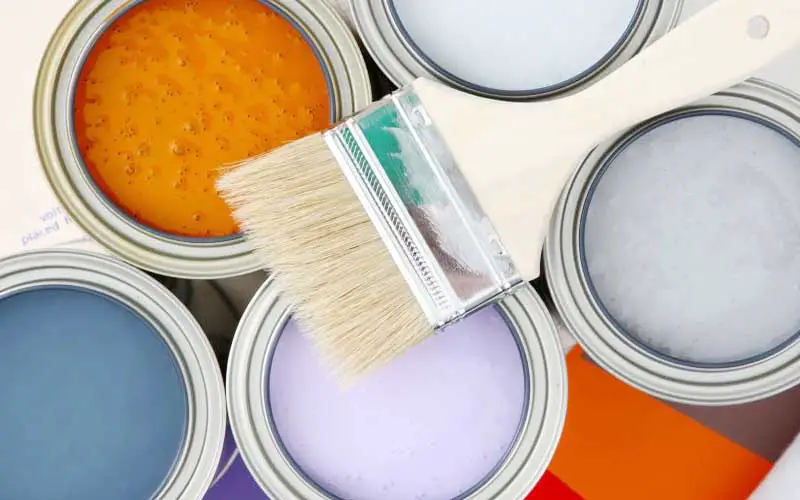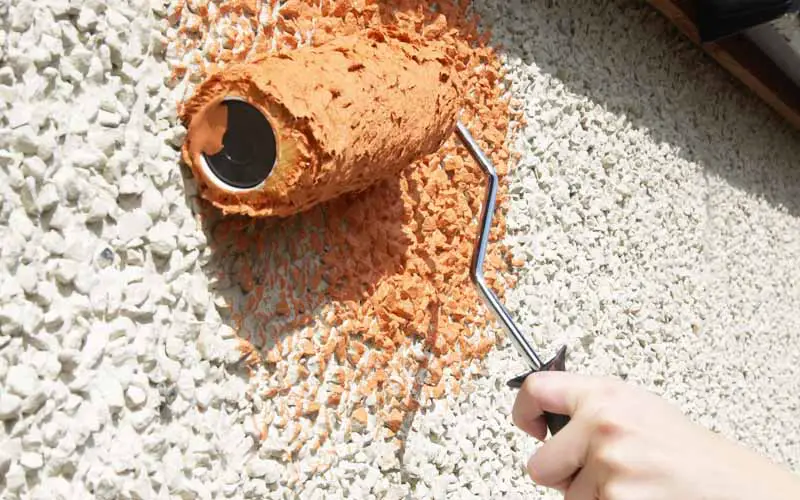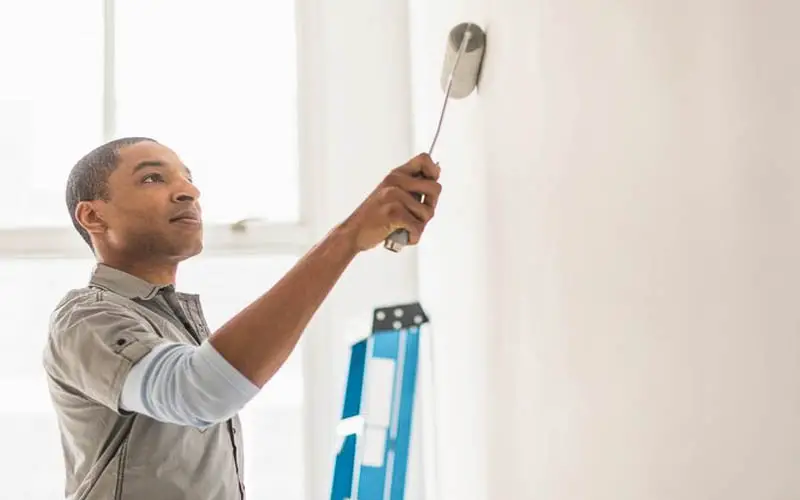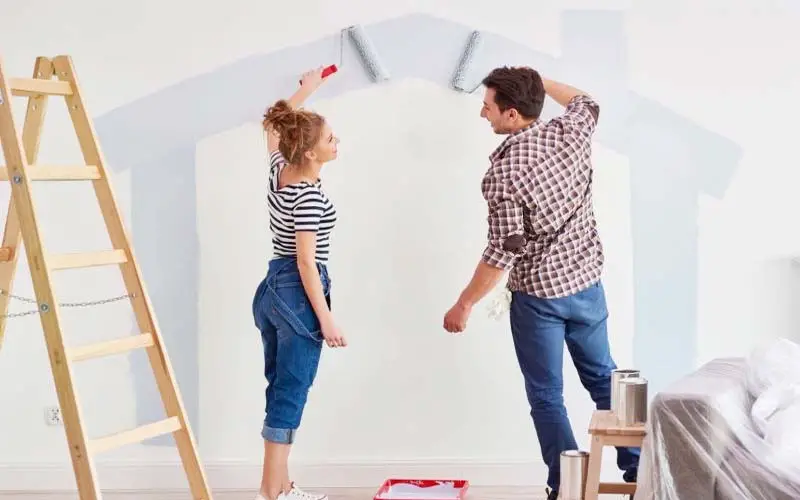
So, you have some leftover paint from a DIY paint job outside! Or, are you thinking that exterior paint may be better for the ceiling in your new wet room! In this article, you will find the information you need to answer that all-important question of ‘Can I use masonry paint indoors’.
Exterior paints are designed to protect your home from the elements. However, they contain chemical additives that can harm your health. It’s important to remember that paint fumes can cause adverse respiratory problems. It is for this reason that, although technically you can use exterior paint indoors, I do not recommend that you do so.
Read on to find out more and make an informed decision on the paint you want to use!
Contents (Jump to Topic)
What’s The Difference Between Exterior & Interior Paint?

Understanding the different ingredients and knowing how paint works is an important factor when choosing any paint. Don’t worry it’s not complicated and I will give you some basics to help you on your way.
Different Base Types
Household paints come in two main forms, water-based and oil-based.
- Oil-based paints are mainly formulated for use on exterior walls and are not usually used for painting interior walls.
- Whereas, water-based paints can be found being used for both internal and external paint projects.
In simple terms, the base allows you to apply the pigment (colour) and any other additives required to all types of different surfaces. Once applied the drying process begins and the base quickly starts to evaporate, leaving behind just the pigment (colour) and any additives that have been added.
Different Additives
Certain additives have to be added to ensure that exterior paint is durable and capable of dealing with all weather conditions. For example, to be mildew resistant mildewcides or certain fungicides may be added. While to be durable, yet flexible, resins are added, this allows the paint to stretch and contract in different temperatures.
Unfortunately, some of these ingredients emit VOCs and chemical fumes and these can cause respiratory problems when inhaled. It is, therefore, extremely important that you take appropriate safety measures. Always work in a well-ventilated area and wear appropriate breathing equipment if recommended. This is especially true if you are using a paint sprayer.
For durability, different resins are used, it is the type of resin that dictates how durable the paint is. Although acrylic resin gives the strongest bond and the highest durability, it also emits the strongest fumes and odour. For this reason, you will find that most indoor paints have epoxy and silicone resins.
These various flexible acrylic resins make the paint flexible and adaptable to outdoor temperature changes. While UV protective additives (Ultraviolet blocking additives) help prevent fading.
Not only are some exterior paints dangerous for your health whilst in use, it’s important that you also dispose of any left over paint correctly.
Paints designed for interior use don’t need to have these qualities and therefore contain fewer chemicals. That being said, paint for interior use is formulated to be stain-resistant, washable and durable.
What Are VOC’s (Volatile Organic Compounds)

Image source: Ecopaints.com
Volatile organic compounds are gases that are released into the air by hundreds of different household products. Although most are from man-made chemicals, VOCs are all around us, even wood-burning stoves can emit VOCs.
If you are exposed to high quantities of VOCs you may suffer from irritation to your eyes and throat, or in the worst cases, have difficulty breathing or feel physically sick. Although not all VOCs have the same adverse effects on your health, most have more than one symptom.
A lot of outdoor paint products release large concentrations of these gases and should be handled and used with care. We have interior paints for a reason, so why risk your health by using exterior paint indoors.
A study on Science Direct shows that some exterior paints can emit other chemicals, such as acetic acid as well as VOCs. With some lasting long after your painting task is complete.
So, Can You Use Masonry Paint Indoors?

Masonry paint seems like the natural choice for people who want to ensure durability indoors. However, while there is nothing stopping you from using it on your interior, as you have seen above, there are some serious considerations and consequences to consider.
Exterior paint is just that, paint that is designed specifically for use outdoors. It is formulated for use on outdoor surfaces such as bricks, mortar and concrete. And, just as interior paints would not be able to protect your home from the elements, use exterior paint indoors and you may not achieve the results you want.
Rather than using exterior paint indoors, you would be much better off using silk paint instead of matt paint in rooms that are subject to higher wear or humidity levels. Silk paint is semi-waterproof and can withstand moisture and cleaning.
Always be aware of the dangers of using exterior paint inside your home please don’t expose yourself or your family to these toxins unnecessarily.
What Can You Do If You Have Accidently Used Exterior Paint Indoors?

If you’ve accidentally painted your interiors with exterior paint, depending on the type of paint used there are various things you can do.
- If the room is well ventilated and the paint finish is ok, leave it as is.
- If it smells strong then open windows and doors to ventilate the area, use fans if need be.
- Refrain from using the room for at least a few days until the strong odour disappears.
- The smell may linger for some time if this is the case, seek advice from a paint professional and consider repainting with the appropriate interior paint.
Final Thoughts & Overall
By using good quality waterproof masonry paint you are protecting your home from moisture, mildew, fading and weathering for between 5 and 10 years. Whereas, paint for indoor use is made to take the wear and tear of family life, allowing for scrubbing and easy cleaning while being long-lasting.
There is a good reason for the great selection of paints that homeowners have available to them. Outdoor paint for outdoors and interior paint for indoors, simple. Always read the label thoroughly and follow the manufacturer’s instructions and you will end with a good job done.
Frequently Asked Questions About Exterior Paint
In the long run, using the correct paint for your DIY paint projects is important to avoid premature breakdown and flaking paint. It is also imperative to understand the effects of the VOCs that some paint emits, I hope this article has helped you to do that.
To finish off, below I will answer some common questions that people ask. Happy house painting.
Is it okay to use masonry paint in a garage?
It is fine to use masonry paint in a garage, just make sure that it is well ventilated. However, unless you already have the masonry paint, interior paint will work just as well.
Can I use the exterior paint in my bathroom to prevent mould?
Although technically you could use exterior paint in the bathroom to prevent mould, personally, I don’t recommend the use of exterior paints indoors. There are bathroom friendly paints on the market with an anti-mould additive, these are ideal for both bathroom ceilings and walls, however, be sure to follow the instructions carefully.
Does masonry paint wash off?
Once dry masonry paint will not wash off. Unlike interior paints, masonry paint is designed to withstand the elements. Additives in exterior paints help to prevent mould, provide water resistance and UV resistance to the paintwork on your house.
Is Dulux Weathershield toxic?
Dulux Weathershield contains various chemicals to prevent mould and mildew and if ingested could be toxic. It can cause eye irritation if splashed and inhalation of mists produced by spraying must be avoided as this may cause respiratory irritation.
How long does masonry paint last?
There are many variants that affect how long masonry paints last. The type of surface, type of paint, along with climate and weather to name a few. However, on average exterior paints will last between 5 and 10 years.

1 comment
Hi Cara
Could you please give me some advice? I decorated my flat with sandtex external paint about 6 months ago… I’ve been reading it shouldn’t be used internally… would you recommend sealing it and repainting? I’m worried it’s dangerous